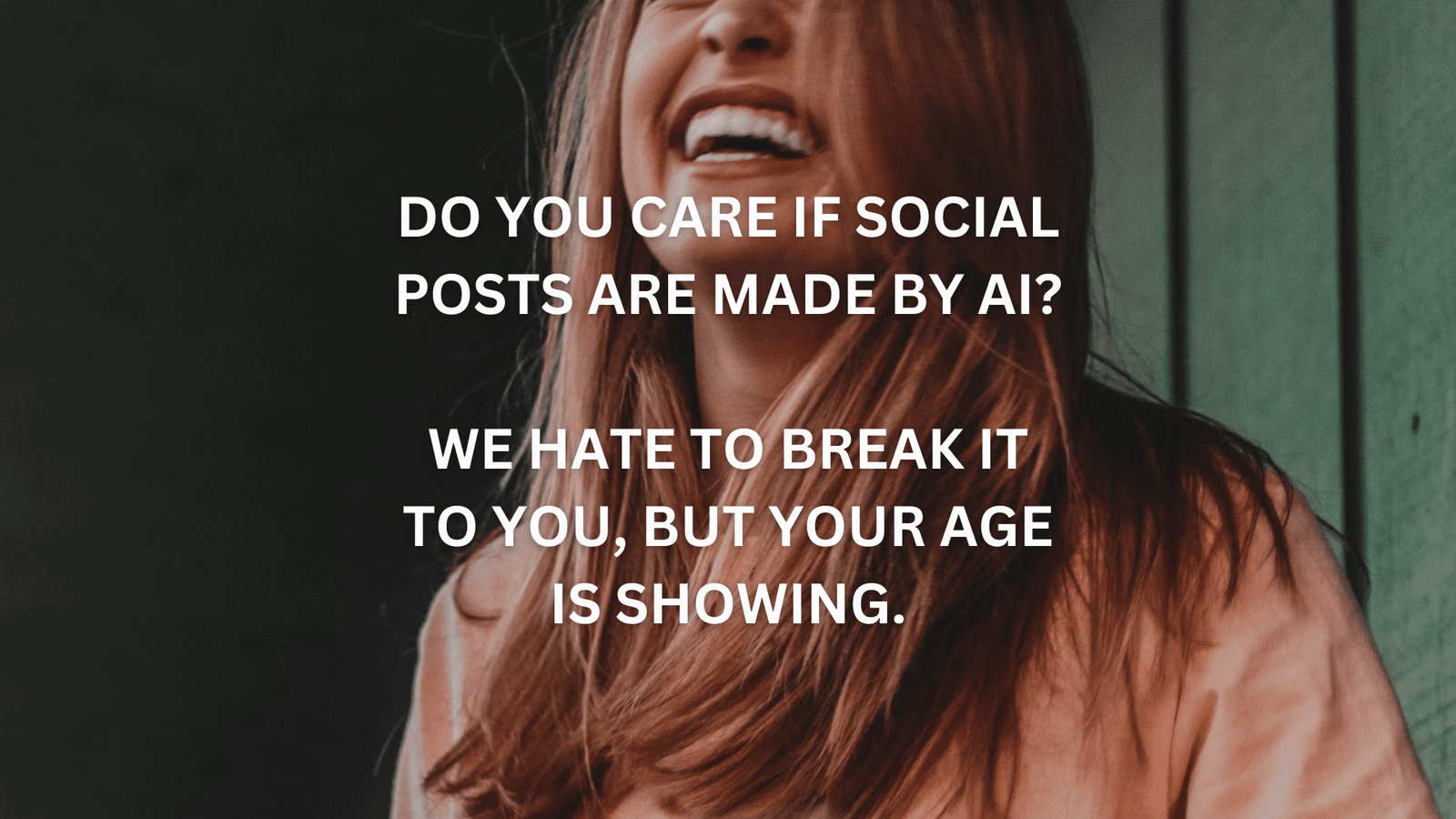Are social media posts made with AI still authentic - how you judge it is based on your age

Should LinkedIn and other social media platforms introduce a small label on posts to indicate what proportion was created with AI? It's an idea that sparks strong opinions - and how strongly you feel about it likely depends on your generation.
In 2024, Sprout Social found that only 35% of Gen Z respondents considered authenticity a top trait when evaluating influencers. In contrast, older generations like Millennials, Gen X, and Baby Boomers still value personal alignment and perceived genuineness as key to who they follow and engage with.
But does this shift only apply to influencers? Or does it speak to something bigger - the very nature of how we interact online?
Generational Shifts in What Counts as “Authentic”
Older generations often view authenticity as sincerity, vulnerability, and real human emotion. A grainy photo of a family dinner or a typo-filled post about a tough day at work can feel more "real" than a perfectly polished, brand-friendly update. For Millennials, Gen X, and Boomers, this imperfection communicates truth. You didn’t workshop that caption—you just spoke from the heart.
But for Gen Z, the meaning of authenticity is evolving. This generation, raised with smartphones and the internet from birth, is more media-savvy and arguably more skeptical. They know that “authentic” is often just another aesthetic. A post might look candid but still be carefully orchestrated for maximum engagement.
So rather than chasing "realness" in the traditional sense, Gen Z seems more interested in transparency and credibility - and sometimes that credibility is judged by quantifiable metrics like follower count, not emotional resonance. According to the same Sprout Social survey, 47% of Gen Z care more about how many followers someone has than whether their content feels sincere.
That doesn’t necessarily mean they don’t care about substance - but it does suggest they don’t take “authenticity” at face value.
What Happens When Most Posts Are AI-Generated?
AI content creation tools are exploding, and it's never been easier or cheaper to generate hundreds of social posts in minutes. This has implications not just for influencers and brands, but for everyday users on platforms like LinkedIn, Twitter, or Instagram.
If younger generations are less concerned about whether a post was written by a human, and more concerned about whether it’s interesting, informative, or performs well algorithmically, then the human-touch content will inevitably be outpaced.
Think about it: one person can spend 45 minutes composing a thoughtful post about their career growth, carefully wording it to avoid sounding arrogant or vague. Meanwhile, another user can generate 10 slick, keyword-optimised posts in the same amount of time using a large language model like GPT-4 or Claude.
It’s not hard to guess which user’s content will dominate the feed.
The Blurred Line Between Influencers and Everyone Else
The line between influencer and everyday social media user has blurred dramatically over the last decade. On platforms like LinkedIn, users with just a few hundred followers can go viral if their posts hit the right nerve. Micro-influencers and niche experts have shown that authority and reach don’t always require a massive audience - just the right message at the right time.
That’s why this conversation about authenticity can’t just be about influencers. We’re all influencers now, in some way. Your post might only reach 300 people, but if one of them is a potential client, investor, or employer, that post matters.
And this is where the question of AI authorship becomes more complicated.
Should it be disclosed when a post was created - or co-created - by AI? If so, how? A subtle watermark? A “Written with AI” badge? A percentage breakdown like “80% AI-assisted”? Should platforms implement it, or should the choice be left to the user?
You can probably guess how Boomers and Gen X would answer that question, with an emphatic yes! label it! They’re digital immigrants, not natives, and are more likely to see the presence of AI as something noteworthy. But Gen Z? They might just shrug. If the content is good, it’s good.
The Follower Count Balancer
Of course, not all content is created equal and garbage is still garbage even if AI wrote it. Generating a hundred posts doesn’t guarantee any of them will perform well. Social media platforms still reward engagement, not volume. Poorly written or spammy posts, AI-generated or not, are unlikely to gain traction.
That’s where follower count and credibility still act as balancing forces. Just like Gen Z prioritises follower numbers when evaluating influencers, platforms prioritise social proof when deciding what content to show more people.
So even in a future where 80% of posts are written by AI, it’s not necessarily a race to the bottom. Garbage won’t be rewarded - at least not for long.
But this brings us full circle: what if the most successful posts are not the most human, but the most optimised? And what does that mean for our expectations of authenticity in a world where machines can mimic human voice with uncanny precision?
AI Disclosure: Symbol or Signal?
Let’s say LinkedIn does implement a label that tells you whether a post was written by a human, co-written, or entirely AI-generated. Would that change how you feel about the content?
Maybe. Maybe not. But the fact that we’re even asking suggests that we still value the idea of human creativity. We just express it differently depending on our cultural and generational lenses.
Older users might see a fully human-written post as more valuable or trustworthy. Younger users might not care, unless the content is bad. For them, what matters is whether the message lands, not whether a human typed every word.
In that context, AI labels could become more of a symbol than a meaningful signal just like the blue check mark has evolved on Twitter/X. Initially a mark of trust, it’s now a badge with its own baggage, depending on how and why it was obtained.
Will AI-disclosure markers go the same route?
A Thought Experiment
This blog post began 100% human-written. It was later enhanced and refined using an AI language model and AI research tools. But if I hadn’t told you that, how would you know? And more importantly - do you care?
If the content was thoughtful, clear, and worth your time, then maybe it doesn’t matter how it was created. But if you're part of a generation that prizes origin and effort over outcome, it might matter deeply.
And that, in a nutshell, is where the future of authenticity is heading: into a grey zone where context, credibility, and culture all collide.
Conclusion: Redefining “Real”
We are rapidly entering an age where “authenticity” will be less about how something was made and more about why it was made and what it achieves. Whether content is human-made, AI-assisted, or fully synthetic may matter less than whether it resonates, informs, entertains, or inspires.
But we shouldn’t dismiss the desire for transparency, especially in professional or personal contexts. Being upfront about using AI tools isn’t shameful - it’s simply honest. And perhaps that’s the new authenticity: not raw emotion or handcrafted syntax, but radical clarity about the creative process.
So, should LinkedIn and other social networks add AI content labels? If you feel strongly that they should, well then OK boomer, and if you don't 'hello, fellow kids'.
But it’s worth remembering: every generation redefines authenticity for itself. The question is not whether we keep up - but whether we care enough to ask the right questions along the way.




Leave a comment